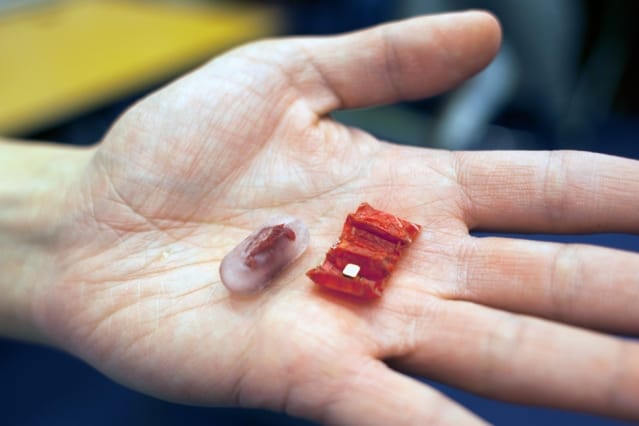
The robot contains of a layer of biodegradable material called Biolefin that shrinks when heated. This is placed between two structural layers of dried pig intestine similar to what is used in sausage casings. After being swallowed, the capsule that houses the robot is dissolved and the structure begins to expand, taking on a rectangular shape with accordion folds perpendicular to its long axis.
A magnet embedded in one of the forward folds allows the robot to be controlled externally. According to the researchers, the forces applied to the robot from outside the body are mainly rotational. A quick rotation of an external magnetic field will make it spin in place, but a slower rotation will cause the robot to pivot around one of its fixed feet. It’s hoped the tiny device could be used to remove foreign objects from the stomach, patch wounds, or deliver medication to a specific point in the digestive system.
“It’s really exciting to see our small origami robots doing something with potential important applications to health care,” said Daniela Rus, a Professor in MIT’s Department of Electrical Engineering and Computer Science.
“For applications inside the body, we need a small, controllable, untethered robot system. It’s really difficult to control and place a robot inside the body if the robot is attached to a tether.”
Once in the stomach, the robot can propel itself using what’s known as a “stick-slip” motion. This involves the appendages sticking to a surface through friction when the robot executes a move, but slipping free again when its body flexes to change its weight distribution. The team tested the device using an artificial stomach. It was able to guide the robot to a button battery in the stomach and use the robot’s magnet to pick the battery up.
According to the researchers, 3,500 button batteries are swallowed every year in the US, and they have the potential to cause damage to stomach lining. One application for the robot would be to help clear these objects through the digestive tract. Rus said the next stages of the project will involve in vivo testing, attaching sensors to the robot, and adapting the device so it can control itself without the need of an external magnetic field.




Nanogenerator consumes CO2 to generate electricity
Nice to see my my views being backed up by no less a figure than Sabine Hossenfelder https://youtu.be/QoJzs4fA4fo